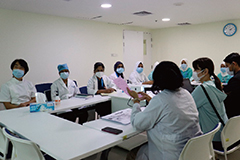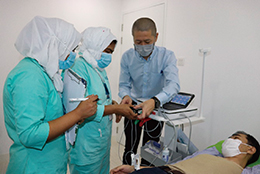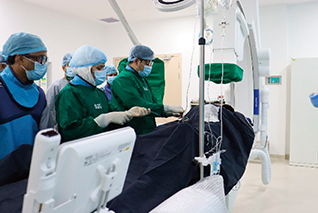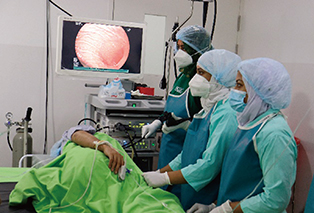Stories from the Field 7
JICA’s Private-Sector Investment Finance (PSIF) Supports the Establishment and Operation of a General Hospital by Japanese Private Companies in Bangladesh

A joint team made up of Japanese and Bangladeshi staff carrying out a meeting on drug management (Photo: SAMSL)

A Japanese staff member taking the role of a patient in a training exercise (Photo: SAMSL)
Bangladesh suffers from a chronic lack of medical care facilities and healthcare workers, and people often have to go to medical facilities in neighboring countries to receive appropriate tests and treatments. Therefore, it is a major issue to develop the domestic medical care system.
A delegation from Ship Healthcare Holdings, Inc., a company with experience working on ODA projects in Viet Nam, Myanmar, and other countries, visited Bangladesh medical college hospitals in 2013, and witnessed the severe medical situation, and consequently decided to establish and operate a general hospital in the country. “At the time, patients were sleeping on the floor, for example, even in medical college hospitals, and adequate medical care was not fully provided. We thought we would like to somehow create a medical environment where the people of Bangladesh would be able to receive appropriate tests and treatments within their own country,” said Mr. KOBAYASHI Hiroyuki, an Executive Director at the company.
In 2016, the company established a local subsidiary, Ship Aichi Medical Service Limited (SAMSL), and embarked on facility expansion of East West Medical College and Hospital*1 to increase the number of hospital beds from 250 to 650, and on operation of the hospital. JICA invested in SAMSL in 2018 and has provided support for this project at Ship International Hospital, aiming to improve medical care standards of Bangladesh by utilizing the expertise of Japanese hospital administration.
In this project, the hospital was renovated and expanded according to the latest Bangladesh National Building Code,*2 based on the belief that medical facilities must be able to function even at times of disaster. Meanwhile, taking safety into account, the hospital was equipped with infrastructure, such as electricity, air conditioning, water facilities, and others, that would meet the same standards as those of Japanese hospitals. Furthermore, the new hospital also introduced the latest medical equipment and facilities, and adopted the Japanese-style of consultations and examinations such as outpatient reception systems using ID cards
“The Japanese style of hospital operation takes hygiene-related aspects into consideration in its design, including the separation of patients and medical staff movement lanes. Whereas there had been sanitation issues in the old hospital such as dirty items and clean supplies being placed together, the introduction of the Japanese-style movement lanes has enabled appropriate management of these issues,” said Mr. Kobayashi.
There was a big struggle to change the mindsets and behaviors of the local staff, accustomed to protocols and operational practices that had been in place for many years. “It is difficult to get people to understand unexperienced new routines through verbal explanations alone. However, when we work together with the local staff and they experience the success of new methods that bring about a good result, they would tell their colleagues in their workplaces about the advantages of these methods. By developing leaders among local staff continuously, we expect that these leaders will play a central role and that levels among the local staff as a whole will be gradually improved,” said pharmacist Ms. ISHII Kasumi.
Due to the COVID-19 pandemic, the construction period had to be extended and the official opening of the new hospital was delayed, but it had a pre-opening in October 2019. After that, it began operation as a Government-designated COVID-19 hospital in June 2020 based on the strong requests of the Government of Bangladesh. The hospital made a significant contribution to the treatment of COVID-19 patients, accepting over 1,600 patients by the end of September 2021, 1,500 of whom were discharged healthily.


Tests taking place using cutting-edge medical devices: an angiography device (left) and endoscope (right) (Photo: SAMSL)
*1 The hospital’s name at the time. With the inauguration of the SAMSL project, it opened under the new name of “SHIP INTERNATIONAL HOSPITAL.”
*2 Bangladesh’s new earthquake-resistance standards (draft version), revision work on which was carried out with JICA assistance in 2015.
<< Previous Page Next Page >>
Main Text | Reference Statistics | Stories from the Field | Master Techniques from Japan to the World | ODA Topics
